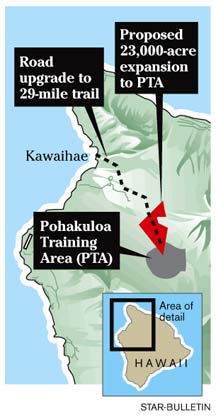
|
Stryker projects on
$164.5 million in Army construction
begins soon on Oahu and the Big Island
With its key legal battles behind it, the Army will begin construction next month of the first of 28 projects designed to prepare Schofield Barracks and the Big Island's Pohakuloa Training Area for its newest unit -- the Stryker Brigade Combat Team.
![]()

Cost of the Stryker projects on Oahu and the Big Island is estimated at $693 million and could extend into 2010.
Borne said the Army can now enter into serious negotiations with the Richard Smart Estate to acquire 23,000 acres of Parker Ranch on the Big Island to be used as a maneuver area for the 19-ton, eight-wheeled Stryker vehicles.
Borne said up to $30 million may be spent to expand the 108,792-acre Pohakuloa Training Area. With more than 300 vehicles assigned to the 3,500-member Stryker unit, the Army needs an area as large as Pohakuloa to train together. It also will include a parachute drop zone.
Borne said all the 28 Stryker-related projects were placed on hold after Earthjustice, representing Ilioulaokalani Coalition, Na Imi Pono and Kipuka, went to federal court last August and challenged the results of the Stryker Brigade Combat Team's environmental impact statement.
Last week, Chief U.S. District Judge David Ezra rejected that Earthjustice complaint and a companion one challenging an agreement between the Army and Campbell Estate on the sale of 1,402 acres of land adjacent to Schofield Barracks along Kunia Road. The South Range land will be used as a training area, a new $50 million Stryker motor pool and a $5 million rifle and pistol range. Construction will begin this year.
Ezra's decisions mean the Army can resume transforming the 25th Infantry Division's 2nd Brigade at Schofield to the more mobile Stryker unit. One Stryker unit is already working in Iraq.
Earlier this year, an internal Army report said the vehicle bogs down in mud and the engine strains under 5,000-pound armor added by the Army. The report also said the armor's extra weight has caused problems with the automatic tire-pressure system, requiring crews to check the tires three times a day.
Other projects planned for this year include spending:
>>$8 million to modernize five pistol, rifle, machine gun, sniper and mortar-firing ranges at McCarthy Flats at Schofield.
>>$7 million to purchase 27 acres of easement to build a 12-mile vehicle trail between Schofield Barracks and Helemano Military Reservation.
>>$30 million to upgrade the platoon live-fire range at Schofield.
>>$3.5 million to build a vehicle wash area at Schofield.
>>$7 million to install a tactical Internet system at Schofield Barracks and Pohakuloa.
>>$24 million to construct a vehicle deployment preparation at Wheeler Army Airfield.
» $30 million to replace existing live fire ranges at Pohakuloa.
Still to be funded, Borne said, are projects to:
» Build a 15-mile road between Schofield Barracks and Dillingham Military Reservation to take Stryker and other 25th Division vehicles off city roads. The new road would be built in 2010.
» Upgrade the parking aprons that will be used by C-130 cargo and troop transport aircraft at Wheeler Airfield. Construction is set for 2010.
» Build a 30-mile private military road on the Big Island from the port of Kawaihae to Pohakuloa Training Area.
» Lengthen and straighten and reorient the existing 4,750-foot runway to accommodate C-130 propellor-driven and C-17 Globemaster jet cargo planes at Pohakuloa by 2010.
The first of seven C-17 jets will arrive in January from Boeing's Long Beach facilities. The C-17 is a critical portion of the Pentagon's humanitarian and strategic Pacific airlift operation, which includes being able to transport Schofield's Stryker Brigade Combat Team to any place in 96 hours.
The first two dozen vehicles should arrive at Schofield Barracks in May 2006. Eventually, the 25th Division will have 300 Stryker vehicles that can be outfitted in 10 different ways, with everything from a 105-mm cannon for a mobile gun system to a completely wired command center. Each Stryker costs about $1.5 million.
The tracked combat vehicles and another 810 soldiers will be assigned to the Tropic Lightning's 2nd Brigade, which last month completed a year's combat tour in Iraq.
The first soldiers seeking assignment to the Stryker brigade should arrive later this year, Borne said, as part of the Army's summer normal job rotations. By October, the 2nd Brigade will grow to more than 3,850 soldiers from 3,000.
The unit should be operational by May 2007, Borne added.
The Stryker, named after two Medal of Honor recipients, is the brainchild and legacy of retired Army Chief of Staff Gen. Eric "Ric" Shinseki. The Strykers, much lighter than the 67-ton M-1A1 Abrams tanks, were conceived to be easily deployed. They are the first new Army vehicle to enter service since the Abrams tank in the 1980s.
[News] [Business] [Features] [Sports] [Editorial] [Do It Electric!]
[Classified Ads] [Search] [Subscribe] [Info] [Letter to Editor]
[Feedback]
